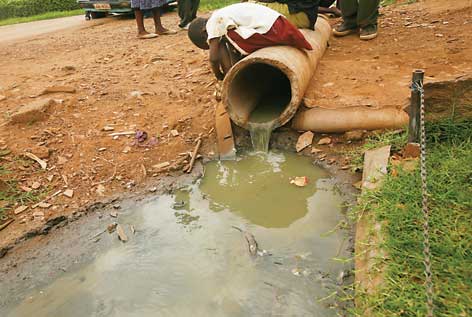Water shortages are happening faster than expected.
Harare has joined the Indian city of Chennai, India and Manila, Philippines, that have endured water scarcity due to extended drought, polluted water and aging infrastructure.

A few weeks ago, the 4 drinking water reservoirs feeding Chennai, India were almost completely dry.
End of June 2019, nearly 14 million residents in Metro Manila and nearby areas were facing water supply problems as Angat dam, their main water source, breached the critical depth:
Now 2 millions of residents of Harare, the capital city of Zimbabwe, are facing a catastrophic situation as officials have decided to turn off the taps!
Sophie Mbugua writes in Climate Home News:
Just 50% of 4.5 million people in Harare and four satellite towns currently have access to the municipal water supply, the city authority told Climate Home News.
“There is a rotational water supply within the five towns,” Harare city council corporate communications manager Michael Chideme said. “Some people are getting water five days a week especially in the western suburbs, but the northern suburbs are going for weeks without a drop in their taps.”
Chideme said people were either depending on water merchants, open wells, streams or several council-drilled boreholes. “The situation is bad, period!”
Dr Jean-Marie Kileshye from WaterNet warned Harare’s water was highly polluted: “Water-borne diseases linked to these boreholes are on the rise, but people have had to take in their own hands water supply because the utility has failed to provide water.”
But wait, here some more:
The dams that feed Morton Jaffray – Chivero and Manyame – are larger and closer to capacity, said Harare mayor Herbert Gomba. But they are “heavily polluted”, requiring more than 10 chemicals to purify. Upstream towns dump domestic, sewage, agricultural and mining waste into the rivers that feed the capital’s dams. The city is spending $3 million a month on water treatment chemicals, Gomba said, forcing it to restrict the amount released.
The video below was captured near Mt Darwin. It shows people taking (polluted?) water directly from the dam after failing to receive tapped water for months:
The worst for the end:
Zimbabwe is getting warmer; heavy rains and droughts are becoming more intense. In Harare, rains are expected in October at earliest, according to James Ngoma of the Zimbabwe Meteorological Services Department.
In 2018, a drought warning was issued to Zimbabwe by the Southern Africa Development Community. But those messages were not getting through, said Brad Garanganga, a climate scientist from Zimbabwe. Under-resourced meteorological departments had not been able to help policy makers “make decisions to take action on this type of important information ahead of time rather than wait until a crisis hit”.
Meanwhile, China is stepping in to fill the void in Zimbabwe’s water crisis and outreach to other African nations in what could be a new kind of mutually beneficial infrastructure projects or hidden colonialism.
Without water no life! A lot of people will die in Zimbabwe in the next few weeks and again, nobody will talk about it.











